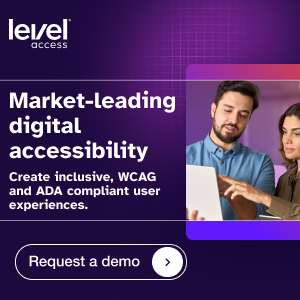If your organization operates within or is planning to expand to the European Union (EU), accessibility should be a crucial consideration. EU laws mandate digital inclusivity not only for public-sector organizations, but also for many private businesses. To meet regulatory requirements, organizations should conform to EN 301 549: the harmonized European digital accessibility standard. Because of this standard’s critical role in legal compliance, aligning with EN 301 549 should be a priority in your EU strategy, whether you serve businesses, government agencies, or the public.
What is EN 301 549?
EN 301 549 is a European accessibility standard that outlines technical accessibility criteria for Information and Communication Technology (ICT) products and services. Developed by a consortium of European agencies, this standard provides detailed guidance for ensuring that various technologies—including hardware, software, websites, mobile apps, and telecommunications equipment—are accessible to people with disabilities.
EN 301 549 harmonizes digital accessibility standards across EU Member States, creating a unified framework for assessing and improving the accessibility of ICT products and services. Conformance to EN 301 549 is required for technology products and services within the scope of the EU Web Accessibility Directive (WAD) and is a best practice for compliance with the European Accessibility Act (EAA).
The relationship between EN 301 549 and WCAG
EN 301 549 incorporates the Web Content Accessibility Guidelines (WCAG) as its foundation for digital accessibility requirements. The latest version of EN 301 549, version 3.2.1, integrates WCAG 2.1 in its entirety. This alignment ensures that the standard is consistent with globally recognized accessibility best practices.
While WCAG primarily focuses on web and mobile content, EN 301 549 expands its scope to include hardware, telecommunications, and other ICT components. This broader application makes EN 301 549 a valuable framework for comprehensive digital accessibility.
EN 301 549 vs. WCAG: A comparison
Now that we’ve briefly discussed the relationship between EN 301 549 and WCAG, you might be wondering if there are other similarities and differences between the two standards. The following table illustrates how EN 301 549 and WCAG compare to one another in key areas.
Your EN 301 549 conformance checklist
Organizations aiming to conform to EN 301 549 can start by implementing the following key accessibility best practices:
- Offer alternatives for visual and auditory content: Ensure information is available in multiple sensory formats. For instance, include meaningful alt text for images, provide closed captions for videos, and offer transcriptions for audio content.
- Provide flexible input methods: Users should be able to navigate and interact with digital platforms using the keyboard only and with alternative input devices, not just with a mouse or touch screen.
- Ensure compatibility with assistive technologies: Digital platforms should function seamlessly with assistive tools like screen readers. Providing screen reader compatibility involves using logical headings and subheadings, descriptive link text, and proper labeling for interactive elements such as form fields.
- Have your websites tested regularly by accessibility experts: Engaging an expert digital accessibility solution provider that offers both automated tools and manual evaluations can help you successfully identify and resolve potential barriers.
Since EN 301 549 incorporates WCAG 2.1 Level AA, organizations that are already compliant with laws (such as ADA Title II) that refer to the global standard are well-positioned to achieve conformance with EN 301 549. An accessibility expert with experience supporting EU organizations can help you align with any relevant EN 301 549 criteria not included in WCAG.
EN 301 549: Standardizing digital accessibility in the EU
EN 301 549 serves as a cornerstone for digital accessibility in the EU, equipping organizations with a clear framework for compliance with laws like the EU WAD and EAA while aligning with global best practices. By understanding and implementing this standard, organizations can create inclusive digital experiences that meet legal requirements and work for all users.
FAQs about EN 301 549 conformance
What types of organizations need to conform to EN 301 549?
EN 301 549 conformance is mandatory for public-sector agencies covered by the EU WAD. Additionally, private businesses covered by the EAA—including businesses that provide banking, e-commerce, and transport services to EU consumers—should meet this standard to demonstrate compliance.
How is EN 301 549 different from WCAG?
While EN 301 549 incorporates WCAG 2.1 as its foundation for web and digital content accessibility, it addresses a wider range of ICT products and services, beyond websites and mobile apps. These include hardware, telecommunications equipment, and software.
If my business is compliant with the ADA, am I conformant with EN 301 549?
While the ADA itself does not explicitly require privately-owned companies to conform to WCAG 2.1, it is commonly cited in case law as a benchmark for digital accessibility. And if your business is conformant with WCAG 2.1, you’re well on your way to EN 301 549 conformance. However, EN 301 also includes additional criteria related to hardware and software products. An accessibility expert can provide you with more insight into your organization’s WCAG conformance posture and other criteria that are applicable to your products under EN 301 549.
